Garden Journal : Our garden, Our freedom [EN/FR]
Hello gardeners and all the other people reading me on Hive! I’m really happy because, with @altheana, our vegetable garden is starting to take a nice shape.

It’s our very first one and I see it as a real source of fulfillment. So here’s a little tour.

To start with, the potato field. These are “charlottes”. In France, it’s a good variety known for fries. Next year, I plan to plant something else there: B75. My grandfather used to plant that and managed to keep his potatoes for more than a year!
Although he can no longer grow vegetables, he did so for 70 years (since he was 20), tested several kinds of potatoes and says that B75 is the most versatile.

Anyway, Saturday morning, before leaving for our parents’ place, we made mounds. That means we pulled the soil between the rows up to the base of the potato plants.
This allows two things:
- To help the stems stand up and avoid breaking from wind or rain.
- To prevent the first potatoes from coming out of the soil and turning green in the sun. If they do, they become toxic.

Next, in what I call the main garden (not the biggest, but the most diverse), we have six strawberry plants. But we feel we won’t get many strawberries this first year.
Maybe we’ll have better luck next year.

Little by little, as we work the soil, it will become more fertile and the yield will be better. I’m (slowly) learning about permaculture. But for now, I don’t apply anything in the garden.
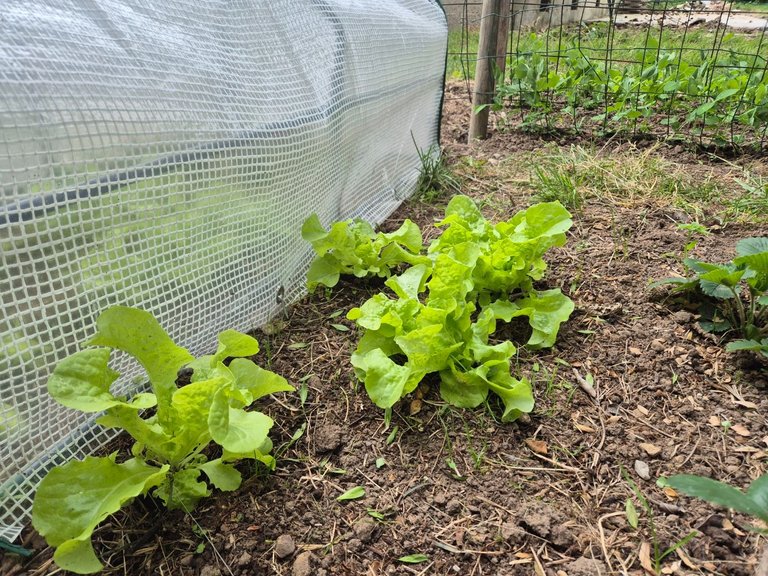
Next to the strawberries, we have four lettuces. In the greenhouse just behind, there are about ten more, as well as five red pepper seedlings I forgot to take pictures of.
My mother says we’re lucky with our lettuces because slugs are leaving us alone.
Indeed, we don’t see many. However, we have lots of moles digging under the garden. Apparently, it’s not a big deal since moles only eat insects. On the contrary, they loosen the soil under the roots and help them reach more nutrients.

Just behind the greenhouse, we have six cherry tomato plants. A gift from @altheana’s parents. We planted them too close together, but at the time we had no choice because we absolutely wanted them under the greenhouse due to risk of frost (which we did have).
Now that the cherry tomatoes have grown tall, the greenhouse is too small and we’ve moved it (to put the red peppers there before planting). And now we realize our tomatoes don’t have enough space.
In reality, we need 60 cm between each plant, and nearly 1 meter between rows. Here, we have 15 cm between each plant and 30 cm between rows.
The only risk is a low yield. It’s not a big deal because, at the very least, we worked the soil. It’s something done for next year.

Let’s now move to another strip of the main garden. Here, you have to squint to see the young tomato plants. Our niece’s boyfriend kindly gave them to us. They’re different varieties from his dad’s permaculture garden.
To see them better and give them enough moisture to avoid watering too much, we wrapped each plant with a bit of dried grass clippings. So, everywhere you see wrapped dried grass, there’s a tomato plant. There are five.

On this same plot is a very young red pepper plant. Among the six we have, it’s the only one we’ve planted as a test. And in hindsight, the others will wait. For now, I’m keeping them in the greenhouse where it’s between 20 and 30 degrees, so the stems can thicken before planting.

Finally, still on this same plot: kale, a gift from my mother this time. It’s a vegetable that will grow up to around 60 cm tall.

In front of this second plot are thyme and parsley. To avoid stepping on them (which happened a few times), we placed some sticks found in the barn. We’ll make something prettier later.
They’re thriving here, but I’m sure they’ll thrive even more now that no one will step on them since they’re more visible.
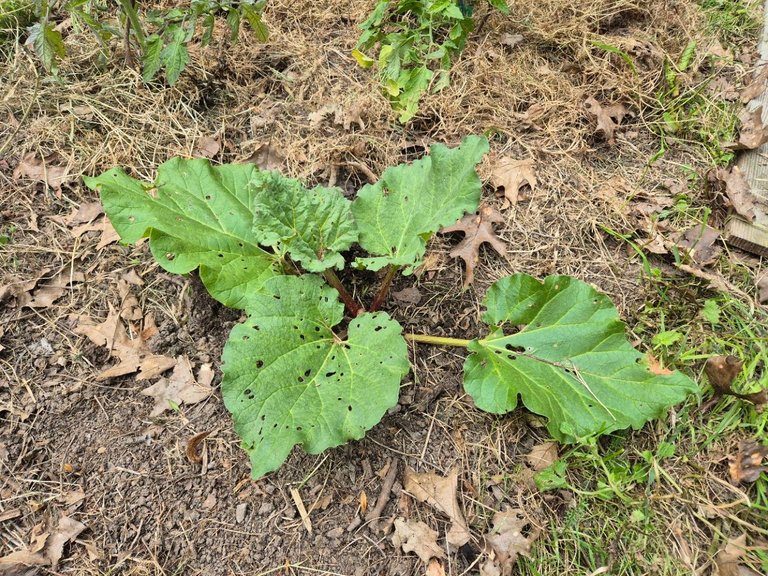
Now let’s move to the third plot of the main garden. Here is a rhubarb plant we planted a few weeks ago, when it only had two small stalks.

Even though it took some time to produce new ones, it’s now growing quickly and we see a new stalk appear every week.

Next to this rhubarb plant, six more well-developed tomato plants. There are also several varieties:
- Black Krim
- Pineapple
- Zebra
- Marmande
- Etc.

Finally, on the fourth plot of our main garden are:
- Two rows of peas (along the fences)
- One row of radishes in the foreground
- Two rows of spinach (we just did the sowing)
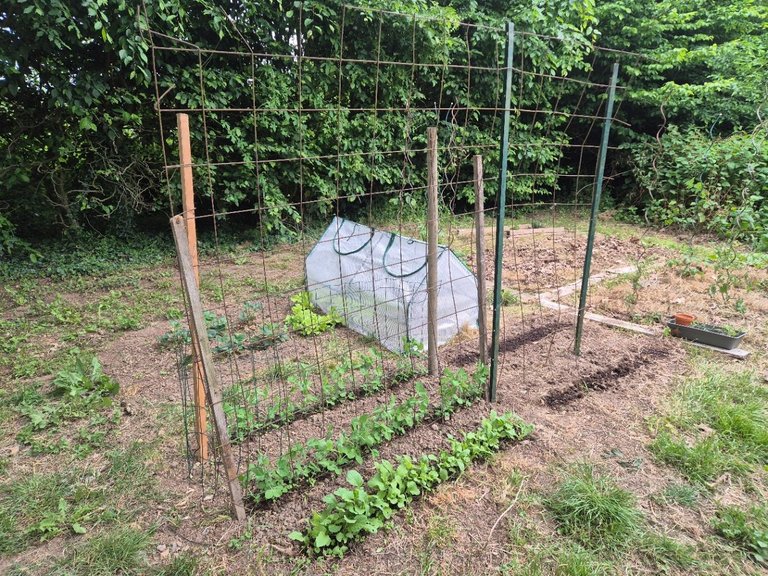
Here’s an overview of the main garden divided into four plots.

In front of the garden, against an old kennel, are three raspberry plants and a mint plant. As for the mint, we chose to leave it in its pot. It’s an extremely invasive plant and we don’t want it everywhere. Also, it likes humidity, so we placed it close to the water tank. It’s quite humid there, as the wall behind the tank shows.

The first raspberry plant I planted has produced its first shoot. It’s visible in the photo above to the left of the main plant.
I took the photo a few days ago already. Since then, it’s much taller. But as I’m not at our house this week, I can’t take another picture.
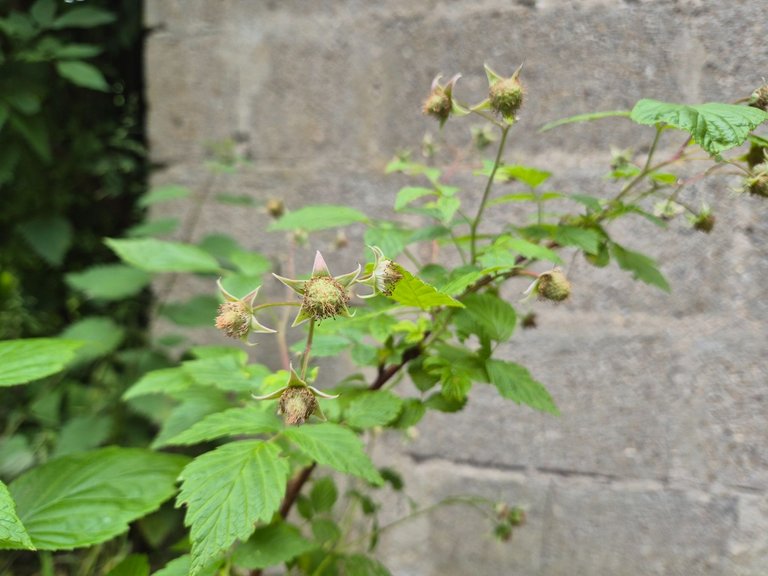
In addition to its shoot, the first raspberry plant will likely give us a few raspberries!
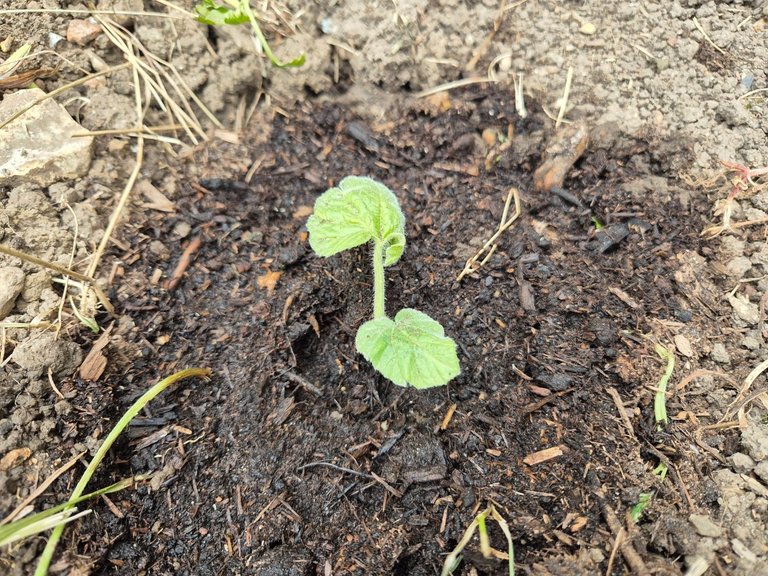

Finally, elsewhere in the garden, we planted two butternuts grown from seeds of a butternut we germinated this winter!
And that’s it, our garden will mostly give us tomatoes and potatoes, a few radishes, some peas, lettuce, spinach, a few fruits and above all, a lot of joy!
Version Française
Bonjour les jardiniers et toutes les autres personnes qui me lisent sur Hive ! Je suis vraiment content parce qu'avec @altheana, notre potager commence à prendre une belle forme.

C'est notre tout premier et j’y vois là un réel épanouissement. Voici donc un petit tour.

Pour commencer, le champ de pommes de terre. Ce sont des "charlottes". En France, c’est une bonne variété reconnue pour les frites. L’année prochaine, je compte y planter autre chose : de la B75. Mon grand-père plantait ça et réussissait ensuite à conserver ses pommes de terre pendant plus d’un an !
Bien qu'il ne puisse plus faire de potager, il en a fait pendant 70 ans (depuis ses 20 ans), a testé plusieurs sortes de pommes de terre et dit que la B75 est la plus polyvalente.

Quoi qu’il en soit, samedi matin, avant de partir chez nos parents, nous avons fait des buttes. C’est-à-dire que nous avons ramené de la terre qui se trouvait entre les rangs vers les pieds des plants de pommes de terre.
Cela permet deux choses :
- Faire en sorte de tenir les tiges et éviter qu’elles ne se cassent avec le vent ou la pluie.
- Éviter que les premières pommes de terre sortent de terre et verdissent au soleil. Sous peine de quoi elles deviendraient toxiques.

Ensuite, dans ce que j’appelle le potager principal (ce n’est pas le plus grand, mais c’est le plus diversifié), nous avons six pieds de fraises. Mais nous avons l’impression que nous n’aurons pas beaucoup de fraises cette première année.
Peut-être que nous aurons plus de chances l’année prochaine.

Petit à petit, à force de travailler la terre, le sol se fertilisera et la production ne sera que meilleure. Je suis en train de me former (doucement) à la permaculture. Mais pour le moment, je n’applique rien au jardin.

À côté des fraises, nous avons quatre salades. Sous la serre juste derrière, il y en a environ dix, ainsi que cinq semis de piments rouges que j’ai oublié de prendre en photo.
Ma mère dit que nous avons beaucoup de chance avec nos salades car nous sommes épargnés par les limaces.
Effectivement, nous n’en voyons pas beaucoup. En revanche, nous avons beaucoup de taupes qui creusent en dessous du potager. A priori, ce n’est pas bien grave dans le sens où les taupes se nourrissent uniquement d’insectes. Au contraire, elles retournent la terre sous les racines et permettent donc à ces dernières d’aller chercher plus de nutriments dans le sol.

Juste derrière la serre, nous avons six pieds de tomates cerises. Un cadeau des parents d’@altheana. Nous avons planté les pieds trop proches les uns des autres, mais nous n’avons pas eu le choix au moment de la plantation car nous voulions à tout prix les placer sous la serre puisqu'il y avait encore des gelées à craindre (et nous en avons eu).
Maintenant que les tomates cerises ont pris en hauteur, la serre est trop petite et nous l’avons décalée (pour y mettre les piments rouges avant de les planter). Et c’est là que nous nous rendons compte que nos tomates n’ont pas assez d’espace.
En réalité, entre chaque pied, il nous faudrait 60 cm d’espace, et entre les rangs, quasiment 1 m. Là, nous avons 15 cm entre chaque pied et 30 cm entre les rangs.
Ce que nous risquons est simplement une faible production. Ce n’est pas grave, car à minima, nous aurons travaillé la terre. Ce sera quelque chose de fait pour l’année prochaine.

Passons à présent à une autre bande du potager principal. Ici, il faut plisser les yeux pour voir les jeunes plants de tomates. C’est le copain de notre nièce qui nous a gentiment offert ces pieds. Ce sont plusieurs sortes de tomates issues du potager en permaculture de son père.
Pour mieux voir les pieds et leur fournir suffisamment d’humidité pour éviter de trop les arroser, nous avons enroulé autour de chaque pied un peu d’herbe de tonte séchée. Ainsi, partout où vous voyez de l’herbe séchée enroulée, se trouve un pied de tomate. Il y en a cinq.

Sur cette même parcelle se trouve un très jeune plant de piment rouge. Parmi les six que nous avons, c’est le seul que nous avons planté en guise de test. Et avec un peu de recul, les autres attendront. Je les laisse pour le moment dans la serre où il fait entre 20 et 30 degrés, afin que les tiges grossissent avant de les planter.

Enfin, toujours sur cette même parcelle : du chou kale, un cadeau de ma mère cette fois. C’est un légume qui montera à 60 cm de hauteur environ.

En face de cette seconde parcelle se trouvent le thym et le persil. Pour éviter de marcher dessus (ce qui nous est arrivé plusieurs fois), nous avons placé des bouts de bois trouvés dans la grange. Nous ferons quelque chose de plus beau plus tard.
Ils s’épanouissent ici, mais je suis sûr qu’ils vont d’autant plus s’épanouir que plus personne ne leur marchera dessus maintenant qu’ils sont un peu plus visibles.

Passons à présent à la troisième parcelle du potager principal. Ici se trouve un pied de rhubarbe planté il y a quelques semaines, alors qu’il n’avait que deux petites tiges.

Même s’il a pris du temps avant d’en refaire de nouvelles, il va maintenant très vite et nous voyons une nouvelle tige apparaître chaque semaine.

À côté de ce pied de rhubarbe, six autres pieds bien avancés de tomates. Il y a plusieurs sortes également :
- Noires de Crimée
- Ananas
- Zebra
- Marmande
- Etc.

Enfin, sur la quatrième parcelle de notre potager principal se trouvent :
- Deux rangs de petits pois (contre les grillages)
- Un rang de radis au premier plan
- Deux rangs d’épinards (nous venons de faire les semis)

Voici donc une vue d’ensemble du potager principal découpé en quatre parcelles.

En face du potager, contre un ancien chenil, se trouvent trois pieds de framboisiers et un plant de menthe. Pour ce qui est du plant de menthe, nous avons fait le choix de le laisser dans son pot. C’est une plante extrêmement invasive et nous ne voulons pas en avoir partout. De plus, c’est une plante qui aime l’humidité. nous l’avons donc placée au plus proche du récupérateur d’eau. L’humidité y est assez importante, comme en témoigne le mur derrière le récupérateur.

Le premier plant de framboisier que j’ai planté a fait son premier rejet. Il est visible sur la photo ci-dessus à gauche du pied principal.
J’ai pris la photo il y a quelques jours déjà. Depuis, il est beaucoup plus grand. Mais n’étant pas à notre maison cette semaine, je ne peux pas le prendre à nouveau en photo.

En plus de son rejet, le premier pied de framboisier nous offrira sûrement quelques framboises !


Enfin, ailleurs dans le jardin, nous avons planté deux butternuts issus de graines d’un butternut que nous avons fait germer cet hiver !
Et voilà, notre jardin nous donnera principalement des tomates et des pommes de terre, un peu de radis, quelques petits pois, de la salade, des épinards, quelques fruits et surtout, beaucoup de bonheur !
The English translation was done using the DeepL API, and the images were taken with my smartphone.
We appreciate your work and your publication has been hand selected by the geography curation team on behalf of the Amazing Nature AN Community. Keep up the good work!
Wow, thank you for that commitment! 😀
I remember when you started with the preparation of the land and now you even have a greenhouse! It is wonderful to see how little by little you have more variety of plants, there is nothing like enjoying what you have grown with your own hands. Soon you will be able to eat a salad complete with vitamins and real flavour, hehe. What a pity not to be able to see those raspberries, as I love them.
I have picked this post on behalf of the @OurPick project! Check out our Reading Suggestions posts!
Please consider voting for our Liotes HIVE Witness. Thank you!
Thanks for your comment, thank you for being here so long! I always saw my grandparents in a vegetable garden, and my parents afterwards. So that's the logical next step for me. The satisfaction of seeing your garden grow is very important. When friends come to the house, I always take them around the garden, explaining all the difficulties and successes I've had with each plant. I know for a fact that we will have a lot of potatoes, too much for our consumption. But I also know that I could offer some!
Then it's family tradition, you'll do fine. I have some neighbours with gardens on the outskirts of the city. When this time of year comes they do like you will do with the potatoes. I've always thought it gives them more satisfaction to share it out among the neighbours than to eat it themselves. Too bad you're so far away. 😜
!LOLZ
lolztoken.com
Because they make up literally everything.
Credit: marshmellowman
@genesisledger, I sent you an $LOLZ on behalf of hive-103505
(5/10)
Delegate Hive Tokens to Farm $LOLZ and earn 110% Rewards. Learn more.
!BBH
!ALIVE
Hi!
It looks beautiful. And you continue the family tradition, how nice to see how everything grows. Some things may take longer than others to settle in, I wish you success.
👋🏻
Hey! Thanks for your pleasant comment. I look forward to reaping the benefits of this work. Although, to be honest, I love taking care of the garden and harvesting will mean that winter is approaching.
Thanks again for your comment and thank you for taking the time to read my post!
You are so lucky you have your grandfather's wisdom to draw upon! I can feel your satisfaction and fulfillment oozing from this post - it doesn't take much to get hooked to growing your own food, does it?
The HIVE GARDEN COMMUNITY supports gardening, homesteading, cannabis growers, permaculture and other garden or botanical related content. Delegations to the curation account, @gardenhive, are welcome! Find our community here!
Completely yes! I only think about that, almost night and day, haha 😀🙈
I'm really curious about the B75 variety you mentioned! The most versatile? Does that mean it's the easiest to care for?
I was wrong in the publication; it is the BF15. It is more popular with good restaurateurs, especially Michelin-starred chefs, because it is more tasteful. On the other hand, it is more susceptible to disease than "Charlotte."
I’ve always wanted to try growing my own veggies but never knew where to start. Seeing your garden journey makes it feel more possible
It was @calendulacraft who told me to just start with something small; the rest will follow.
In fact, just give it starting inertia. Like when we have to do work in the house, we start by buying what we need. Then, a few days later, we install the hardware in 10 minutes. Then, a few days later, we slowly start doing the work.
To start the garden, I simply collected seeds from a butternut squash, deposited them in a damp handkerchief while waiting for them to germinate. I then bought pots and placed my seeds in pots with soil. And everything went on from there. The crazy thing is that, knowing I was starting a vegetable garden, everyone around me wanted to give me a seed or a plant of a vegetable they liked.
There is not just one way to start. It doesn't matter if it works or not; the important thing is to be in action and conduct your own experiments.
Wow this is really cool.
Cant wait till harvest time.
Great job!! Well done!!
!ALIVE
Thank you for taking the time to read and comment! 👍
What a wonderful homestead you have! Everything started with every small step; keep up the good work. The effort and time invested will pay off soon.
And soon you will have enough veggies for household consumption. Just imagine, everything grown naturally and from the fruit of your labor, just rewarding!
Happy gardening! 💚